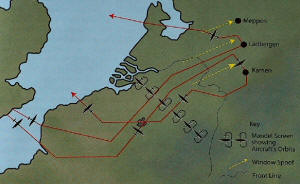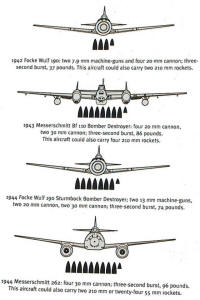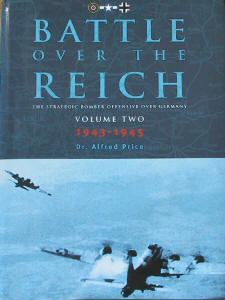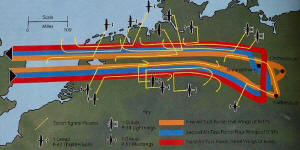|
Classic Publications |
|
Battle Over the Reich The Strategic Bomber Offensive Over Germany Volume Two 1943-1945 |
|
by Dr. Alfred Price |
|
Reviewed By John Ratzenberger, #40196 |
|
|
|
MSRP: $49.95 USD Hardcover: 9"x12", 160 pages, satin-glossy. Illustrated: 250 photos (some in color), 10 color profiles, some maps, diagrams, charts, and tables. ISBN: 1-903223-48-2 Available from Specialty Press, www.specialtypress.com, 1-800-895-4585, ($4.95 S/H fee). I would like to thank Specialty Press and IPMS for providing the review sample. Preliminaries: Because this is a two-volume subject, I do not want to repeat too much from the review of the first volume. So, if you have not already, please see: Battle Over the Reich, Volume One. If that does not work, then go to the Reviews main page, then select Indexes & Archives, then Archive Index, then Books, and look down about 15 lines for "Air War Classics Battle Over the Reich v1". Bottom Line Up Front: This is a very well written and illustrated summary history of the strategic air war over Germany from the perspective of the 3 main protagonists -- Germany, Britain, and the United States. As with Volume One, I thoroughly enjoyed this book and highly recommend it for the contents -- but I'm having second thoughts about the total price of $90 to $100 for both volumes. Review: Volume Two picks up from Volume One in November 1943 with the US licking its wounds after Schweinfurt and building up the day bomber and fighter forces and the RAF still conducting its war at night. From there, Dr. Price nicely leads us through the strategic air war against Germany, with particular emphasis on the war of attrition on the Luftwaffe itself. Throughout Dr. Price points out that although German fighter production was still formidable the loss of trained aircrew, the reduction in fuel supplies, and the transportation problems that prevented delivery of supplies were insurmountable problems. Although the book touches on high level decisions, and has folded in some nice individual action vignettes, the bulk of it falls into a broad middle range, touching on development and changes in tactics and technology and discusses the tradeoffs and rationale on both sides as the air war evolved. It covers aircraft capability, flak weapons, ground and airborne radar, and other topics, all in a very logical and complimentary fashion so that one is not skipping around and changing thoughts all the time. Much of the book focuses on the German side, which is logical, the story of the Allied success is better told from the German side. The Allies were winning the war of attrition and could just keep "running at the line" to use a football analogy (and the American style of warfare); the Germans, loosing that same war of attrition, had to make more decisions, face more challenges, etc. The book concludes with a chapter on German weapons in development, but notes the shortage of fuel, parts, and adequately trained aircrews really meant they had no chance to change the course of the war. The pictures are, again, excellent -- an eclectic and well-chosen mix of aircraft and weapons; anti-aircraft weapons, radars, and sites; leaders, pilots, and aircrew; targets before and after, operational scenes, and so on. One I found very interesting (diorama prospect) was boards used to wedge a Lancaster's bomb-bay doors open, presumably to prevent them being closed on the loading crew by accident. The detail comments in my review of Volume One still apply, with the note that there are a few more editing errors in Volume Two. The most significant is the Strength of the Luftflotte Reich chart in Chapter 10 where it appears the 10s-digit has been left off the Number Available figures for JGs 1, 3, 5, and part of JG 11. Others are minor -- in the picture on page 182, the radar aerials on the Fw190 are on the port wing, not starboard; on page 280, the Mossie serial number is given as LR503 (text) and LF503 (profile); and on page 299-300 the sole aircraft shot down by the Me163 Jagerfaust was both a Lancaster (text) and a B-17 (caption). The most annoying is the Table of Contents lists Appendix D, E, and F -- but the actual Appendices are A, B, and C. To make matters worse, Appendices A & B (A-D, B-E) are identical in both volumes and not really significant in either. The third appendix, C or F, covers "Code Names" and are different between the volumes, but again, not overly useful. All 3 appendices fit on one page. Unfortunately, Volume Two did not resolve what I considered the most significant omissions -- footnotes and a bibliography. As I said before, given the style of the book, I can do without the former, but never, especially considering the total cost of these two volumes, the latter. I have to wonder why this was produced in this "coffee table" format and in two volumes -- it had to drive up the expense. The chapter numbers and page numbers are contiguous, so it is more one book in two volumes than a two-volume set. While Volume One could stand on it's own, Volume Two really does not. I guess two fifty-dollar books were seen as more attractive than one 80 or 90 dollar book, I don't know. I think a less "glitzy" single volume would have resulted in a lower cost yet still highly acceptable and informative work. Summary: Despite the shortfalls, this is a great book -- as my WW2 aviation library is heavy on the Eighth Air Force, I learned a lot about the air war at night and I appreciated the well-written story of the day actions. This volume, as with the first, is extremely well organized and written -- I do not know how one could read them and not be highly satisfied. So, while I highly recommend reading the books, I am not sure I can recommend paying list price for them. If you decide that you want them in your collection, you will not be wasting your money. |
|
Diagram of an 8AF mission showing the escort plan. |
 Diagram of a RAF night mission showing the electronic screen. |
 Comparative weight of ammo fired by German fighters. |
|
Information, images, and all
other items placed electronically on this site |

